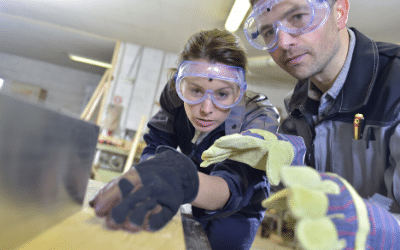
by Clair Mooney | 2 Sep, 2020 | Main News Feed
With additional incentive funding of up to £3,000 now available, taking on an apprentice is a more attractive step for many. Payments are available for employers that take on an apprentice between 1 August 2020 and 31 January 2021 – funding is in addition to the CITB grants available to support a business taking on an apprentice and existing support for training.
From 1 September 2020, employers can apply for these incentive payments for hiring a new apprentice.
Funding payments will be made in three steps:
Step 1: Hire a new apprentice(s) between 1 August 2020 and 31 January 2021 (extention confirmed as 31 March 2021) . FIS can help you with recruitment and selection. Alternatively Recruit an apprentice is the official government service for posting and managing apprenticeship vacancies and traineeship opportunities in England.
Step 2: Apply for the payment after you add the new apprentice(s) to your apprenticeship service account. If you do not already have an National Apprenticeship Services account, please read the guidance and register via guidance to manage apprenticeship funds. FIS strongly encourage all employer members to open an account.
Step 3: You will be eligible for two equal instalments after your apprentice completes 90 and 365 days of their apprenticeship.
Employers can spend the funding payment on anything to support the organisation’s costs, from facilities and travel to uniforms and salaries. This is in addition to the £1,000 payment already available to help employers meet the needs of some groups of apprentices in the workplace.
To register your interest go to apprenticeship.service.gov.uk/ and complete an employer enquiry form. Alternatively, you can call the National Apprenticeship Service on 08000 150 600.
Further Guidance on apply for these incentives if you are based in England is available here,
If you are not based in England and are interested in taking on an apprentice, further information on how to access incentives is available via the links below:
Scotland | Northern Ireland | Wales
Remember, if you are in scope to CITB grants of up to £11,000 may also be available for employers who employ apprentices.
Employer Incentive Payments 2020
FIS employer members are encouraged to apply for funding from source, any third parties offering funding will no doubt mean you receive less than you are actually eligible for. If you need any information, advice or guidance on training, qualifications, apprentices, work placements or eligibility for funding (including CITB grant payments, Local Enterprise Partnership funds and employer allowances via the Department of Work and Pensions) in the first instance please contact FIS via info@thefis.org or 0121 707 0077
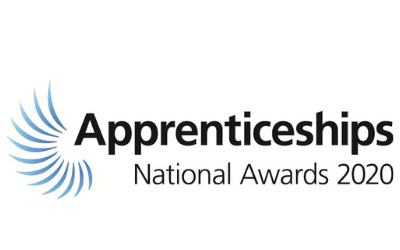
by Clair Mooney | 1 Sep, 2020 | Main News Feed
Calling all apprentices, employers, and individuals who champion apprenticeships… the National Apprenticeship Awards 2020 are now open for entries!
Back for their 17th year, the National Apprenticeship Awards are a fantastic opportunity to showcase the apprentices, employers and champions who have gone above and beyond, in spite of the challenges faced during this pandemic.
Entries to the awards are open until 25 September 2020 and this year’s winners will be recognised via virtual ceremonies. It is free to enter the awards, and all entries must be made through www.appawards.co.uk
There are nine categories to recognise exceptional employers, apprentices and apprenticeship champions:
Employer of the Year categories
• SME Employer of the Year (for organisations with 1 to 249 employees)
• Large Employer of the Year (for organisations with 250 to 4,999 employees)
• Macro Employer of the Year (for organisations with 5,000+ employees)
• Recruitment Excellence (the winner is selected from Employer of the Year award entries, and will be awarded to an organisation that has recruited a diverse and high quality apprenticeship workforce).
Apprentice of the Year and Apprenticeship Champion categories
• Intermediate Apprentice of the Year (level 2)
• Advanced Apprentice of the Year (level 3)
• Higher or Degree Apprentice of the Year (level 4 or higher)
• Rising Star of the Year* (nominated by their employer, this award recognises apprentices that have made impressive progress in their career to date, and have the potential to go even further)
• Apprenticeship Champion of the Year (recognises individuals who go ‘above and beyond’ to champion apprenticeships. The nomination is made by a colleague or contact who recognises an individual’s ‘champion’ credentials).
* The Rising Star category will not include a public vote this year due to the condensed format of the awards
There are two webinars to explain the awards process in more detail, including hints and tips on completing your application. These can be accessed here:
• Employer and Rising Star webinar
• Apprentice and Apprenticeship Champion webinar
Regional Ceremonies will take place online between 2 and 6 November, with the national ceremony taking place online on Wednesday 25 November.
To find out more about the National Apprenticeship Awards 2020 please visit: appawards.co.uk

by Clair Mooney | 1 Sep, 2020 | Main News Feed
CITB is looking to offer remote learning as a permanent delivery format. To ensure that what they offer really meets industry needs CITB would like to collect information on the following areas:
- Which employers are requesting and/or would be interested in remote learning continuing to be on offer from CITB?
- What employers reflect are the benefits and/or advantages of remote learning continuing? (i.e. easier for the workforce to undertake, reduces costs, travel, overnight stays etc.)
- Which training courses would employers like to remain as part of the remote learning offer from CITB?
Responses can be sent directly to Julia Stevens Julia.stevens@citb.co.uk. The closing date is Tuesday 8 September. Please indicate your membership of FIS on your response.

by Clair Mooney | 28 Aug, 2020 | Main News Feed
A draft recovery plan for the construction sector in Scotland has been launched today by the Scottish Construction Leadership Forum (CLF). The plan, which has been created collaboratively with industry, sets out the pathway for joint action between industry and the public sector in response to the impact caused by the global pandemic on the on the construction sector.
The construction industry in Scotland has, like many others, been hit hard by the Covid-19 pandemic. The sector in Scotland which provided £7.8 billion GVA to the Scottish economy and employs 143,000 people in over 50,000 enterprises, is estimated to have contracted by 28.6 per cent in June as a result of the Covid-19 pandemic compared to the same month a year ago (June 2019).
The recovery plan has been created through extensive consultation and collaboration with more than 50 organisations across business, Scottish Government, trades unions and other bodies, including the Construction Industry Coronavirus (CICV) Forum, and represents a shared view from across the sector of a plan to get industry back on its feet.
The plan outlines the immediate and short-term response to Covid-19 and sets out a pathway between this and the longer-term transformation required to build a stronger, fairer and greener economic future for Scotland.
Peter Reekie, chief executive of the Scottish Futures Trust and chair of the editorial group of the Construction Leadership Forum, said: “The construction industry in Scotland has received a major blow from the Covid-19 pandemic. However, the level of collaboration which has gone in to preparing this Recovery Plan is unprecedented and sets a strong foundation for transformative recovery for the industry. I urge all stakeholders with an interest in the construction and related industries in Scotland to feed in your thoughts to make it even stronger.”
Ken Gillespie, chair of the Industry Leadership Group, said: “This plan has only been possible through the depth of collaboration across the sector, and hard work of all involved, and demonstrates the sector’s ability to come together in a time of crisis. This is only the beginning though. The plan will evolve and respond to reflect the feedback and the needs of the sector. We are therefore calling for industry to review and contribute to the plan.”
The plan identifies five areas for concerted and collaborative efforts over the coming months and has established Sub-Groups to develop and progress joint action plans:
- Pipeline and Commercials
- Skills and Workforce
- Transformation
- Supply Chain Resilience and Capability
- Industry Data and Insight
The plan calls for key actions to respond to immediate needs which include:
- A clear pipeline of work brought to market quickly and efficiently on fair commercial terms which reflect the reality of the Covid-19 environment.
- Support of employment, fairness of work and those who may become unemployed through what will be a difficult period.
- Transformation of working practices to maintain and enhance worker safety whilst enabling productivity in the Covid-19 working environment.
Housing Minister Kevin Stewart said: “The construction sector supports many other areas of our economy so it is important that we maintain the health and vitality of the industry. In order to develop this plan we have reached new heights of collaboration but we are now keen to hear from the wider industry to ensure that we arrive at a plan that will preserve jobs and help to revive our economy.”
The Scottish Construction Leadership Forum (CLF), which has led the development of the plan, is a collaborative initiative of Construction Scotland and the Scottish Government . It was established in March 2019. Chaired by Housing Minister Kevin Stewart for the duration of the crisis, it widened its membership in response to Covid-19 and has already developed and implemented plans to get the industry safely back to work to develop and implement an action plan of improvement initiatives aligned with Government policies and the Construction Scotland Industry Strategy. Several streams of work are ongoing and prior to Covid-19, the Forum was at the early stages of considering a wider agenda for change across the industry.
The CLF shared vision is of an industry that promotes a safe, productive, profitable, digitally-enabled, low-carbon, and socially responsible construction industry which offers quality jobs and fair work to a highly skilled and diverse workforce and a quality and life-time value product to its customers.
The recovery plan is available to view on https://www.constructionforum.scot/ Industry is invited to provide feedback to the plan via the website by 15 September. CLF will take all feedback on board to help develop the plan further, with regular updates published on the CLF website.

by Clair Mooney | 27 Aug, 2020 | Main News Feed
Today NBS, the leading specification platform for the construction industry, has announced a partnership with trade association Finishes & Interiors Sector (FIS) to drive up standards and compliance through information sharing and best practice amongst construction professionals.
Fit-out is an essential aspect of the construction process, impacting the way a building looks and how it performs. NBS and FIS’s strategic partnership will ensure industry-wide compliance and best practice are pooled, and shared with specifiers, to drive further innovation in the sector.
In line with evolving design standards, this collaboration is part of a mutual commitment to improving the accuracy and quality of specifications, helping to support architects, designers and specifiers’ interpretation of information, and their ability to make informed choices.
For a specifier, interior fit-outs can be complex since there is so much to consider. The partnership seeks to overcome this challenge and provide specifiers with access to latest guidance documentation, informing best practice and validated by industry standards. High quality content and multiple content sets, linking to official design and specification standards are available to download here.
Together, NBS and FIS seek to drive efficiencies, value and better design through specification content and improve the competencies of all that use an NBS Specification, reducing misunderstandings. Utilising NBS Source and NBS Chorus to deliver the most comprehensive, consistent and up-to-date catalogue of building product information and specifications.
Iain McIlwee, CEO at FIS says, “This partnership strengthens our relationship with NBS, taking it to the next level. It draws on the expertise of both organisations to deliver a more consistent and targeted approach in understanding and supporting specifiers’ needs for bold design, better risk management, and compliance.
“Too often detailed design happens long after the building process has started and practical problems undermine intent. Simultaneously, information is not always presented in a way that enables specifiers to make informed choices and compare products and solutions”.
Richard Waterhouse, CSO, NBS, adds, “We are at the epicentre of an evolving construction product landscape, from procedure to policy and with high demand for improved collaboration. With the emphasis of the Golden Thread of Information on the entire design process, manufacturers are being compelled to create a unified and consistent approach to product information, placing accountability at the forefront of decision-making. Specifiers, for their part, are also expected to streamline processes and record details to ensure a safe environment.”
He adds, “Our partnership will enable us to work closely with the FIS and its members to deliver the best quality guidance and consistent standard of information on a single platform that is quickly understood”.
Commenting on the partnership, Sascia Elliott, Head of Partnerships, NBS, says, “Providing high quality information efficiently and accurately, in a cohesive way, promotes best practice and ensures industry structures align. This digital approach to help professionals do their jobs accurately is crucial to promote best practice within the wider construction industry.”
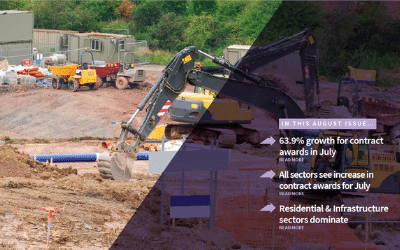
by Clair Mooney | 25 Aug, 2020 | Main News Feed
Raw monthly data underlines growth trend with value of £6.3 billion.
Whilst overall construction output fell by a record 35.0% in Q2, the bulk of that decline occurred in April with data for both May and June showing record output growth. Whilst the normal focus for construction output would be on the more stable quarterly figures, the unusual situation in 2020 means that changes to monthly output data are now in sharper focus. The latest data release from ONS shows that overall construction output increased by 23.5% in June and follows the previous record of 7.6% increase in May. However, despite the strong growth over the last two months construction output in June 2020 is 24.8% below that of February 2020, immediately priorto Covid-19 lockdown. Data for June shows 22.5% increase for new work compared to May whilst RMI output increased by 26.0%. New housing was particularly positive with 39.0% increase for the public sector whilst private sector housing output increased by 42.3%.
The private commercial sector registered a 25.5% increase on the previous month whilst infrastructure new work was more subdued with 6.7% increase.
The UK construction sector in August 2020 is firmly on the path to recovery with output for May and June showing some bounce back. In addition, contract awards data for June and July is extremely positive indicating that the 51.1% slump in new orders in Q2 might be allayed to some extent in Q3. In addition, the Business Impact of Coronavirus Survey undertaken by ONS indicates that the construction sector had 75.5% of staff working at their normal place of work or working remotely between the 15 and 28 June 2020.
FIS members can access the full report here.

by Clair Mooney | 20 Aug, 2020 | Main News Feed
The Construction Leadership Council Smart Construction Dashboard demonstrates housing sector performance using a set of agreed KPI’s and Benchmarks. The dashboard contains maturity metrics for cost, digitisation, waste, energy, productivity (pre-manufactured value), carbon, health, safety and speed of build, and wellbeing. Since the first release of the dashboard in October 2018the sector has evolved. The UK government’s construction transformation funds has enabled housing projects to focus on future performance and innovation. Covid-19 has substantiated the requirement for an accelerated approach to deliver Smart construction. Digital technologies are gaining momentum in the sector, with leading contractors embracing and investing in advanced manufacturing and measurement. We are observing substantial progress with investment to transform the sector, such as the Urban Splash £90M deal with Sekisui, as well as TopHat receiving investment of £75M from Goldman Sachs.
In 2019 our CLC Innovation in Buildings workstream measures working group merged with the demonstrator projects and business case working group enabling the set metrics to be specified on housing projects and to demonstrate best housing practices against the UK Government’s Construction 2025 goals.
I’m pleased to announce the release of our second Housing Dashboard incorporating new data from 2019 to show the performance of the sector against the metrics. Greater guidance will be given for housing providers, developers and contractors to measure the performance on their own housing projects. We have introduced a new health and wellbeing measure, and made enhancements to the dashboard which consist of some new benchmarks, created by gathering better data sources with improved methodologies. The 2020 target is set at a 20% improvement on the benchmark target.
Along with each metric, there is a progress box containing a circle with a number in the middle. The number in the middle of the circle represents the % change between the 2019 benchmark figure and the 2018 benchmark figure. The circles round the outside represent the % progress towards the 2020 target, with the white line representing the % progress made. See below.
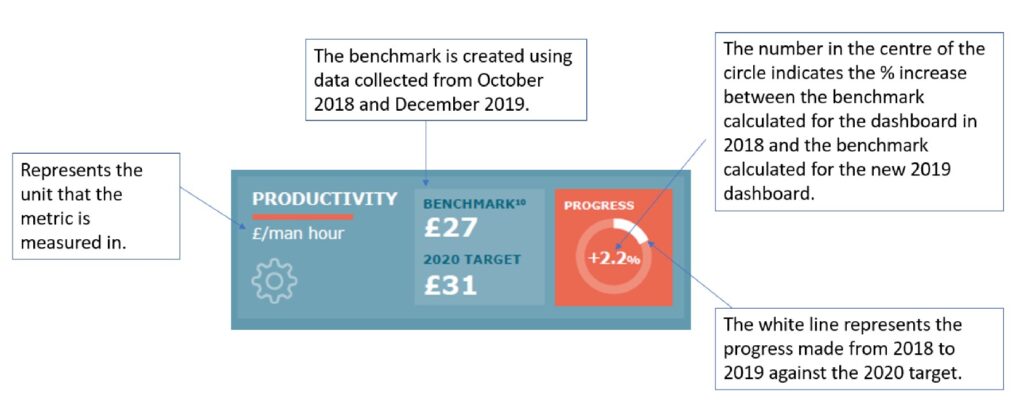
It is encouraging to see new built housing completions were rising in 2019. Based on the data set, improvements have been made across the sector with a lower number of injuries compared to the previous dashboard. Productivity has also improved for the sector. We have recalibrated the capital cost metric and the embodied carbon with new data, added prelims and the new health and wellbeing measure. Waste on site has gone up and time on site has increased in the new build homes sector, this could be for a number of reasons, including reasons like sales rate and Brexit impacts. Quality has not changed, and we are working towards a revised method in the next dashboard release.
I’m also excited to announce a new case study will be shortly available.
The housing sector is, all things being relative, at a “start point” when compared to other advanced industrialised sectors, and much more can be done to adopt innovation, deliver significant increases in productivity, satisfy end customers, and improve construction safety and wellbeing.
The CLC workgroup approach is to create demand and gain buy in for measuring project performance for the housing sector. We want to normalise performance measurement. We know the measures still need to be significantly improved, and we are working towards an improved dashboard later in 2020. Homes England, and innovative housing organisations, like Your Homes Newcastle are applying measures directly on projects, enabling their supply chain to respond to the challenges. The CLC team are determined to work with everyone to make this right, and move the sector forward.
A link to the new dashboard is here.
The Housing Industry Metrics report upon which the Dashboard it is based is linked here.
by Clair Mooney | 18 Aug, 2020 | Main News Feed
The latest Constuction Trade Survey which captures the second quarter of 2020 reveals the extent to which the construction supply chain was affected by public health measures as a result of the nationwide lockdown in response to COVID-19.
Construction was permitted to continue during lockdown in England, but was restricted to coronavirus-related work and essential repairs or maintenance only in Scotland, which accounts for around 8% of construction output in Great Britain. However, widespread pauses in site activity were reported across the UK, particularly in house building and commercial. Not surprisingly, sales of construction products and materials, contractor workloads and surveyor workloads all experienced one of their worst contractions in history in Q2.
FIS members can access the CPA report here.
Additional Market Data is available in our Membership Hub.

by Clair Mooney | 3 Aug, 2020 | Main News Feed
The latest CPA Construction Industry Scenarios (Summer 2020) have now been published which has three scenarios in a similar vein to the Spring Scenarios. In the CPA’s main construction scenario, a V-shape better described as a tick-shape recession and recovery, construction output is anticipated to fall by 20.6% during 2020 before recovery in 2021 during which construction output rises by 18.0% from a low base.
Overall, during the two years 2020 and 2021, the main scenario is similar to the CPA’s Spring main scenario. However, there has been a change in the monthly profile of activity that has led to an upward revision to construction output during 2020 and a downward revision to construction output in 2021.
Since the CPA’s last set of scenarios, activity appears to have returned to site quicker than initially anticipated as house builders focus on completing developments that were halted during the social distancing restrictions to feed pent-up demand that could not purchase between March and May. In addition, contractors also appear to have returned to site at a more rapid rate than expected in Spring as they are keen to finish partially completed projects given contractual requirements. The key exception to this has been in Scotland, which has different guidance on what construction could occur throughout April and May. In addition, the phased return to activity on site has led to a considerably slower recovery in activity, starting in June.
The anecdotal indications were that productivity on site had initially fallen by between 30% and 40%, dependent on the development, due to social distancing and other safety measures. This was expected to hinder project delivery, raising the cost and causing substantial delays to finishing dates. The indications from contractors in July were that productivity on site is no longer 30%-40% lower than pre-coronavirus as indicated in May although this productivity deficit has not fallen to zero at the time of writing and anecdotally remains 10%-15% lower depending on the site. In the Spring main scenario, some social distancing restrictions and other safety measures were assumed to continue into 2021 and, as result, it was expected that it would take longer to address productivity issues on site.
The CPA main scenario anticipates construction output in 2020 falling by 20.6%. It is worth keeping in mind that based on the ONS construction output data so far, to May, even if output were to rise to pre-COVID-19 levels in July and remain at those levels for the rest of the year, which is a very optimistic assumption then overall for 2020, construction output would still be 17% lower than in 2019.
The largest falls in activity are expected in in private housing (-33.3%), public housing (-32.5%) and commercial (-28.5%). The key changes in the main scenario since the Spring publication are a downgrade to public housing and an upgrade to private housing rm&i.
The CPA main scenario anticipates construction output in 2021 rising 18.0% from a low base. The largest growth rates are expected to be in infrastructure (34.6%) and private housing (18.5%).
The CPA also has U-shaped and W-shaped scenarios, described in the document.
FIS members can access the report here.

by Clair Mooney | 31 Jul, 2020 | Main News Feed
The Grenfell Inquiry this week saw more employees from Rydon on the dock. If you don’t already subscribe I thoroughly recommend that you follow the podcasts on BBC Sounds as they come out (weekly). This week we heard from David Hughes (Site Manager), Stephen Blake (Refurbishment Director), Gary Martin (Site Manager) and Daniel Osgood (Site Manager).
The testimonies all make for uncomfortable listening and highlight real gaps in the construction process. In giving evidence Mr Osgood was asked whether he believed that his job was to ensure that work being completed by subcontractors was “compliant” – he replied he “didn’t have the training to do so”. He went on to say that he believed that “anything going on any building is fireproof” and that “all insulation was fireproof as a standard”.
The Project Manager, Gary Martin also got a grilling about foam. He was questioned around the foam selected to seal the windows – he had “assumed” that the insulation was fire resistant. Sadly it seems this assumption was incorrect and that it was wholly inappropriate waterproof seal was used to plug the gap left by the smaller windows – the product didn’t even claim fire resistance. This selection of seals and use of foams remains a real challenge throughout construction – the days of going at a gap with a heart full of hope and a can of “fireproof foam” are surely behind us.
Mr Osgood’s misconception is multi-tiered, but at its core is a concept that I have been raising in talks for the past 5 years. If I google fireproof foam, I get a myriad of results and claims, but the fact is that there is no such thing – a product can be tested for resistance to fire, but no foam is fire proof! Even when a foam is tested to be fire resistant, very close attention should be paid to the scope of use. How often have you removed a ceiling tile to find a large gap oozing orange foam (looking something like an explosion in crunchie factory!) – if you interrogate the test evidence of the foam it is likely that it has only been tested in gaps approximately 10-30mm wide.
SoundProof is another inaccurate claim, products should refer to the levels of sound absorption to reduce reverberation in a space and the sound insulation between spaces which is measured using airborne or impact sound reduction laboratory tests. Sound proofing is often used in claims where hard, dense and imperforate products are used for sound insulation, either airbourne or impact. Products used to improve the quality of sound in a space are absorbent and although they can contribute to reducing sound transmission they have different properties and are generally soft.
We are working with the Construction Products Association, as part of the Grenfell Response, to look at Marketing Integrity. An underlying principle is that performance claims should reflect the test that was carried out, i.e Sound Insulation, Sound Absorption, Fire Resistance or Reaction to Fire.
We must always remember that performance tests are very specific and not interchangeable, for example a product test evidence for reaction to fire can not be used to demonstrate compliance where fire resistance for compartmentation between dwellings is required.
The Inquiry this week is a timely reminder that the ultimate performance of an installed construction product is reliant on a number of things.
- Its intended purpose and appropriate selection and specification
- Test evidence and/or third-party certification for the product for its use
- The installation being done fully in accordance with instructions
and that any interface should be with materials that are equal to or greater than the performance of the products themselves.
Under scrutiny also, particularly in the evidence given by Stephen Blake, was the level of value engineering and impact cost led procurement had on the Grenfell project. Rydon’s bid (£9.2m) was some £700,000 lower than the nearest rival and a staggering £2.1 m less than the original choice contractor. It was within this process that Rydon and façade specialist Harley proposed aluminium composite material (ACM) in either riveted-on or cassette form as a cheaper alternatives to the zinc cladding that was originally specified for the tower (in which Rydon managed to extract greater savings than had been passed on to the client, seemingly to offset in part an error in their bid of £212k).
This substitution and the process was the subject of Mr Hughes cross examining. Mr Hughes admitted that he had approved the decision to switch to the ACM cladding system used, but despite a clause in Rydon’s contract with the Council that said: “The contractor shall not make any substitution for any materials, goods or workmanship… without the prior consent… in writing of the employer.” he did not directly consult building control, the client or the architect about the swap.
The Grenfell Inquiry Hearings will resume in September.
Details of the FIS PPP (Product Process People) Quality Framework are available here
Article by Joe Cilia, Technical Director, Finishes and Interiors Sector (FIS)

joecilia@thefis.org

by Clair Mooney | 30 Jul, 2020 | Main News Feed
Ambassadors are an important link between employers and schools. There are approximately 1400 Ambassadors currently engaged with the programme, representing over 600 employers. Sharing their knowledge of working in the construction industry, Ambassadors ensure young people are inspired and informed on their choice of career opportunities.
The service has been transferred from CITB to Science, Technology, Engineering and Mathematics (STEM) Learning, as the UK’s largest provider of education and careers support in STEM. With over 30,000 Ambassadors and 19 STEM Hubs across the UK, this move will enable the programme to benefit from a wide range of opportunities and support.
This collaboration means the programme for construction can be further developed using STEM’s digital platform as the one-stop shop for all events, feedback and resources. Not only will CITB be able to gain access to events held across all UK secondary schools, but this will enable CITB to better equip Ambassadors with the right resources, making sure the industry is promoted fully and consistently.
To become a STEM Ambassador, you need to register here and select to participate in the ‘Construction and the built environment’ scheme. For guidance on how to register or manage your STEM profile, please visit Go Construct.
To commit to the scheme as an employer, please register here.
FIS would really like to see Ambassadors dedicated to the finishes and interiors sector join the STEM offer, so we have wide approach that our educational partners can easily access encouraging young people into the sector. Being a STEM Ambassador is about engaging and enthusing young people with science, technology, engineering and mathematics. Ambassadors will help encourage students to consider progression into related careers, inspiring the next generation of STEM professionals.
It offers the chance to give something back to education and the wider community, whilst giving individuals the chance to develop their own skills and improve themselves.
“Being a STEM Ambassador is probably the most satisfying aspect of my career. Inspiring kids for the future is the pinnacle of what’s possible and it’s tremendous fun too!” – Derek Langley, Product Manager at Thales.

by Clair Mooney | 30 Jul, 2020 | Main News Feed
The new scheme, designed to match job opportunities to individuals seeking employment and run by the Construction Leadership Council (CLC), went live last Friday (24 July). It’s already off to a very promising start with 482 employers currently signed up to use the scheme, and over 240 vacancies posted, with more being added every day.
If you are a business or individual looking to find out more, please visit the Talent Retention Scheme portal here.
A Covid-19 Displaced Apprentice Project team has been established by CITB; this team will be reaching out to apprentices impacted by the pandemic. They will work with Apprentices to find alternative employment where possible, or signpost them to other support services, including the Talent Retention Scheme.
Apprentices will also be supported by CITB with more practical elements, such as developing CVs and interview preparation, to provide the best possible chance at securing further employment. If you are an employer willing to take on an Apprentice that has been made redundant, register with the Talent Retention Scheme or contact CITB it’s vital the finishes and interiors sector don’t lose these people.

by Clair Mooney | 30 Jul, 2020 | Main News Feed
Manchester Minshull Street Crown Court heard that in the summer of 2015, to support the construction of the A556 bypass in Cheshire, work had started to build a pier designed to eventually support a bridge. This involved erecting a steel cage. On 3 August, two workers on a MEWP were working on the structure, when it collapsed. The cage crashed into the MEWP, causing it to fall on its side.
The first employee sustained life changing head injuries and the second a leg fracture. A third worker nearby escaped injury by moving away just in time.
An investigation by the Health and Safety Executive (HSE) found there was no temporary support for the reinforcement cage during construction of the central pier. Costain Limited was principal contractor and Brenbuild Limited was appointed by Costain to construct seven bridges and an underpass.
Costain Limited and Brenbuild Limited were both aware the cage was visibly leaning and that workers on site had raised concerns. Neither company recognised the inherent instability of the reinforcement cage or took measures to ensure the work could be carried out safely. Brenbuild Limited failed to stop work to prevent injuries from the risk of collapse and to implement control measures to prevent instability. Costain Limited failed to plan, manage and monitor construction of the central pier.
Brenbuild Limited of Parkway Business Park, Scunthorpe pleaded guilty to breaching sections 2(1) and 3(1) of the Health and Safety at Work etc. Act 1974. The company was fined £80,000 and ordered to pay costs of £21,730.11.
Costain Limited of Vanwall Business Park, Maidenhead, pleaded guilty to breaching sections 2(1) and 3(1) of the Health and Safety at Work etc. Act 1974. The company was fined £1.2million and ordered to pay costs of £21,644.51.
Speaking after the hearing HSE inspector Deborah Walker said: “This incident could have been easily prevented and the risk of collapse should have been identified by both companies.
“If a suitable safe system of work had been in place, this incident would not have occurred, and the two workers would not have suffered these injuries.”

by Clair Mooney | 30 Jul, 2020 | Main News Feed
The UK Government is legally bound to reduce emissions to net zero by 2050, which means we will need to change how we build. It includes the retrofit of energy efficiency methods to existing buildings. But how can you and your business benefit?
Government is working with construction organisations to understand what skills the construction industry needs to access the new markets involved and will publish recommendations later in the year. This is a key opportunity to influence and help shape the support employers need. Please complete the CITB online survey which should take 10 minutes and closes on Wedsesday 5 August 2020.
This has been brought the attention of FIS by British Gypsum. The key area of focus for the finishes and interior sector is internal insulation.
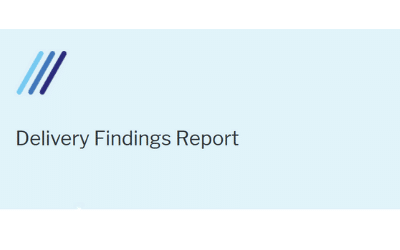
by Clair Mooney | 27 Jul, 2020 | Main News Feed
An inclusive, net zero carbon economy remains at heart of the strategy
KEY RECOMMENDATIONS
• Giving an independent, specialist body the remit to provide strategic, long-term infrastructure advice to Scottish Government
• Enshrining the Place Principle and implementing a one public sector approach to planning and developing sustainable places
• Establishing a Construction Accord to strengthen the future relationship between the public sector and the construction industry
An independent, specialist body to provide strategic long-term infrastructure advice is considered pivotal to effectively delivering Scotland’s inclusive, net-zero carbon economy, according to a final report by the Infrastructure Commission for Scotland (ICS) presented to Scottish Government.
Enshrining the Place Principle and implementing a one public sector approach to planning and developing sustainable places are also key recommendations in the report.
The establishment of a Construction Accord to strengthen the future relationship between the public sector and the construction industry, is another vital recommendation in the Commission’s report.
Published today, the ICS’s report, ‘Delivery Findings – A blueprint for Scotland’ builds on the ICS’s initial ‘Key Findings’ report published in January 2020 and follows a further period of extensive stakeholder engagement, both pre and during the COVID-19 pandemic. Its focus remains the delivery of an inclusive, net-zero carbon economy, the importance of which has only been amplified by the COVID-19 pandemic.
To achieve this, the ICS recommends that by early 2021 an independent specialist body be given the responsibility by Scottish Government to help prioritise the infrastructure needed to enable an inclusive, net-zero carbon economy and to develop a 30-year infrastructure strategy that is reinforced by a long-term needs assessment.
The independent organisation would sit outside the political decision-making system to enable it to operate in an arms-length and transparent way – one that builds confidence across the public and private sectors as well as society and the general public. This would allow the body to challenge Government while also undertaking tactical public engagement to inform the long-term strategy.
Among other ICS’ recommendations is that Scottish Government should enshrine the use by all stakeholders of the Place Principle which has already been proven to be an effective model when designing places within planning practice. This would support the creation of sustainable places and help enable a “one public sector approach” to infrastructure which is central to achieving the Commission’s vision for a net zero carbon and inclusive growth economy.
The ICS also recognises the importance of a thriving construction sector being vital for the successful delivery of Scotland’s long-term infrastructure requirements. While work is already underway to drive positive outcomes to increase productivity, raise capability and improve the reputation of the construction sector, the ICS notes that in light of the impact the covid pandemic has had across the economy, there is a window of opportunity for both the public and construction sectors to strengthen their future working relationship and practice.
As part of this, the ICS recommends that by early 2021, Scottish Government and the Construction Scotland Leadership Group should create a Construction Accord. This would underline the vision and set a commitment to improve conditions that support a high performing construction sector. It would include measures to improve the capacity, capability and diversity of the workforce at all levels with a heavy focus on skills development, training requirements and career prospects for those working in the sector.
Ian Russell, chair of the Infrastructure Commission for Scotland, said: “Infrastructure has a vital role to play in the delivery of an inclusive, net zero carbon economy and COVID-19 has amplified the need for urgent action and change for economic, social and natural infrastructure.
“The Commission is recommending that an independent, specialist body be given responsibility for providing Government with strategic, long-term infrastructure advice and enshrining the place principle within planning practice. Collaboration between the public sector and the construction industry is crucial and therefore establishing a construction accord between the public sector and the construction industry is another vital recommendation in the Commission’s report.”
Other recommendations in the report include harnessing a heightened focus on digital technology. Recognising the critical and increasing importance of high-quality data to infrastructure assets of all types, the ICS advises that a digital data co-ordination, standards and facilitation role is established by the end of 2021 to support the efficient and innovative development and use of data for the infrastructure sector.
Cabinet Secretary for infrastructure, Michael Matheson, said: “The Covid-19 pandemic has been an unprecedented global crisis which has fundamentally changed every aspect of our lives. Infrastructure will play a critical role in the years ahead as we plan our strategic economic recovery from the pandemic.
“I am grateful to the Infrastructure Commission for their hard work – no doubt made more challenging in recent months – to produce this comprehensive second report on the delivery of infrastructure. We shall now take time to consider its findings very carefully.
“The Commission’s Phase 1 report has already helped to shape our next 5 year Infrastructure Investment Plan, details of which I look forward to announcing in September. This Plan will incorporate a response to the Commission’s Phase 1 findings.”
The ICS, which was established in early 2019 to develop Scotland’s infrastructure strategy for the next 30 years, recognised net zero carbon and an inclusive growth economy as two overarching policies that were priorities on both a national and global scale. As such, these priorities were placed at the heart of its work and mark a sharp shift from the broad aim of overall policy convention to maximise GDP over the last 50 years.
The Commission was asked to provide advice to ministers on the possible creation of a Scottish National Infrastructure Company. After careful consideration, the Commission has concluded from its work that none of the outcomes of its recommendations would be enhanced by creation of a Scottish National Infrastructure Company.
On concluding its work, which is believed to be the first of its kind for Scotland, Chair of the Commission, Ian Russell, stated: “We are clear that the implementation of all of the recommendations made in our Phase 1 and Phase 2 reports – some of which we acknowledge will necessitate a fundamentally different way of prioritising, planning and delivering infrastructure investment – will make a significant contribution to the successful creation of an inclusive net zero carbon economy.
“The recommendations from the Commission’s work over the past 18 months are designed to galvanise and accelerate action by all involved with infrastructure in Scotland.”

by Clair Mooney | 22 Jul, 2020 | Main News Feed
The Construction Industry Joint Council (CIJC) Working Rule Agreement, its pay and conditions, would normally have been reviewed at the end of June 2020. In April 2020, all parties to the Agreement agreed to postpone the start of any review discussions, given the Covid-19 emergency and the unprecedented effects this was having on employers, operatives, the industry and across the UK.
Whilst work on many construction sites is restarting, the overall impact on the construction industry remains variable in different parts of the country. As a result, the member trade associations of the CIJC representing employees covered by the CIJC have decided, this week, to extend the postponement of pay negotiations until September, when a further assessment will be undertaken. This decision has not been supported by the trade unions and we await their formal response.
Parties to the CIJC Working Rule Agreement remain in regular contact to monitor progress as the industry moves forwards from the emergency to better understand any ongoing impact on employers, operatives and the industry. In the meantime, all rates and allowances as detailed in the CIJC Agreement dated 1 August 2018 will continue to apply.
Visit our Employment Hub for more information
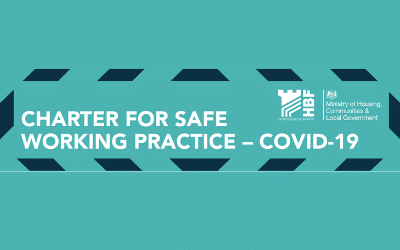
by Clair Mooney | 15 Jul, 2020 | Main News Feed
HBF Wales, in conjunction with the Welsh Government has launched a house building Site Safety Charter to help construction sites reopen in line with latest health and safety guidance.
House builders are gradually returning to work after a three month layoff as a result of the coronavirus crisis.
The document demonstrates a commitment from housebuilders and the wider industry to safe working whilst Covid-19 remains prevalent as well as government support for the resumption of house building and sales activity. Stimulating house building activity can play a major part in supporting an economic recovery – as well as ensuring the supply of desperately needed new homes is maintained.
The intention is that house builders will display the Charter on their sites, reinforcing their commitment to safe working and helping reduce concerns that their workforce, neighbours and customers may have at the current time.
The charter aligns with the Welsh Government’s Coronavirus Regulations and Moving home during the coronavirus pandemic Guidance and the Workplace guidance for employers and employees: COVID19 and has been developed in agreement with CHC Community Housing Cymru and FMB Cymru Federation of Master Builders Cymru.
Stewart Baseley, Executive Chairman of the Home Builders Federation, said:
“Over recent weeks house builders have commenced a gradual return to work, in a structured way that ensures the safety of its workforce and the general public.
“The industry sustains thousands of people in numerous roles and associated sectors, boosting local economies across Wales. A resumption of work will play a major part in helping the economy recover as well as delivering the homes the country needs.
“It should also provide the supply chain with the confidence it needs to accelerate its own restart. The Charter is the public facing evidence which supports the very detailed protocols individual builders now have in place to ensure safe working on sites.”
Minister for Housing and Local Government, Julie James said:
“The need for a secure, safe and affordable home has never been more apparent than during the coronavirus pandemic.
“The contribution of the construction industry to creating more of these homes and the economy has also been highlighted during the crisis. This is why restarting work on building these homes in a safe and controlled manner is vital. This safe working charter will help the construction industry and the social landlords that contract them to do just that.
Aaron Hill, Head of Policy and External Affairs at Community Housing Cymru said:
“The coronavirus pandemic has demonstrated the importance of good quality, affordable homes, and the need for investment in housing to play a key part in the economic recovery in Wales and beyond.
Housing associations have worked tirelessly to maintain a safe working environment throughout this period, and we are pleased to be supporting this charter which will protect the wellbeing of all those who are required to be on construction sites. This charter will play a key part in ensuring sites can operate safely as we work together to deliver the homes Wales needs.”
Ifan Glyn, Director of the Federation of Master Builders (FMB) Cymru said:
“Getting back to building new homes to ensure that we meet housing demand is of course of great importance, but what is more important still is that we do so without jeopardising the sacrifices made to contain the virus during the lockdown period. We, the Federation of Master Builders Cymru, believe that following the commitments set out in this charter will ensure that house builders are able to get back to work safely. We are therefore very happy to endorse this Charter.”

by Clair Mooney | 15 Jul, 2020 | Main News Feed
Guidance has been updated to confirm that from 13 July 2020 providers can welcome back 19 plus apprentices into educational settings, that the flexibility to suspend level 2 functional skills for level 2 apprentices has been extended, and to provide more information on support for redundant apprentices.
This is a difficult time for apprentices, employers and providers of apprenticeship training, assessment and external assurance. The government is committed to supporting apprentices, and employers continue to build the skills capabilities the country needs now and in the future. There are four English Apprenticeships currently available to the Finishes and Interiors Sector:
- Interior Systems installer – Dryliner
- Interior Systems installer – Ceiling and Partitions Installer
- Plasterer – Solid
- Plasterer – Fibrous
The Education and Skills Funding Agency (ESFA) is responding by taking steps to ensure that, wherever possible, apprentices can continue and complete their apprenticeship, despite any break they need to take as a result of COVID-19, and to support providers during this challenging time.
The document sets out guidance for apprentices, employers, training providers and assessment organisations in response to the impact of COVID-19. It outlines the changes that the ESFA is making to the apprenticeship programme during the COVID-19 outbreak.
With the introduction of urgent government measures to reduce the spread of COVID-19 and a rapidly developing situation, these guidelines reflect arrangements applied at the current time. This guidance will be kept under active review and updated regularly with further developments.
The support ESFA are providing includes:
- supporting employers, providers and apprentices to work together to mutually agree where and how training takes place. This includes in the workplace or assessment centre where a provider is able to do so safely and where that workplace or centre meets new ‘coronavirus secure’ guidelines on ensuring the workplace is safe. It also includes training taking place in educational settings in line with the new guidance on wider opening from 15 June 2020, guidance for further education providers, and guidance on what FE colleges and providers will need to do from the start of the 2020 autumn term.
- confirming flexibilities to allow furloughed apprentices to continue their training and to take their end-point assessment, and to allow existing furloughed employees to start a new apprenticeship, as long as it does not provide services to or generate revenue for their employer.
- encouraging training providers to deliver training to apprentices remotely, and via e-learning, as far as is practicable.
- allowing the modification of end-point assessment arrangements, including remote assessments wherever practicable and possible, this is in order to support employers, providers and end-point assessment organisations (EPAOs) to maintain progress and achievement for apprentices.
- clarifying that apprentices ready for assessment, but who cannot be assessed due to COVID-19 issues, can have their end-point assessment rescheduled.
- apprentices whose gateway is delayed can have an extension to the assessment time frame.
- enabling employers and training providers to report and initiate a break in learning, where the interruption to learning due to COVID-19 is greater than 4 weeks.
- confirming that, where apprentices are made redundant, it is UK Governments ambition to find them alternative employment and continue their apprenticeship as quickly as possible and within 12 weeks. If you are making apprentices redundant please contact FIS.
- confirming that where apprentices are made redundant and are ready to go through gateway, that providers and EPAOs are able to make the necessary assessment arrangements to support these apprentices.
- confirming that ESFA are extending the transition period onto the apprenticeship service. Funds available for new starts on non-levy procured contracts can now be used until 31 March 2021. All starts will be through the apprenticeship service from 1 April 2021.
UK Government are keeping the developing situation, and guidance, under review and will continue updating this guidance as new information is available and/or the situation evolves.
ESFA information should be read alongside the government’s COVID-19 guidance and support for businesses, in particular the salary support for furloughed employees, which also applies to apprentices.
ESFA have also broken down some of this guidance into articles for employers, training providers and EPAOs, as well as articles for apprentices. These can be found on the ESFA Apprenticeship Service Help page.
Further information is available from the Institute for Apprenticeships and Technical Education
Provisions IFATE on the delivery of assessment.

by Clair Mooney | 13 Jul, 2020 | Main News Feed
HMRC has published revised guidance on the Coronavirus Job Retention Scheme for both employers and employees which clarifies the position about the ability to claim the scheme’s grants for wage costs during notice periods.
The wording added to the employer’s guidance states:
“You can continue to claim for a furloughed employee who is serving a statutory notice period, however grants cannot be used to substitute redundancy payments. HMRC will continue to monitor businesses after the scheme has closed.”
After studying the guidance, FIS Associate Member Citation, highlighted two important points:
- Firstly, the revision deals with notice periods generally and therefore this will apply in any case where notice is being served – not just redundancy.
- Secondly, the guidance remains unclear on the position where employers are contractually required to give longer notice periods than the statutory minimum (1 week if employed between 1 month and 2 years and after that, 1 week for each full year worked up to a maximum of 12 weeks). Our advice would be that if you want to claim for notice periods beyond the statutory minimum, you should contact HMRC to confirm that this is acceptable.
FIS has created a COVID-19 Employment Toolkit to support companies in managing their workforce.

by Clair Mooney | 25 Jun, 2020 | Main News Feed
If you have to make redundancies, Jobcentre Plus can give you and your employees support and advice through its Rapid Response Service. Support could include:
- helping people facing redundancy to write CVs and find jobs
- providing general information about benefits
- helping people to find the right training and learn new skills
- helping with costs like travel to work expenses
Jobcentre Plus may also provide on-site support for large scale redundancies.
The Rapid Response Service provides local support and helps workers and employers by giving those facing redundancy access to the services of Jobcentre Plus and its partners before they lose their jobs. The support available through the Rapid Response Service is not just about Jobcentre Plus services – where appropriate other partners, such as the LSC, the devolved administrations, Local Authorities and Local Enterprise Partnerships will be involved to provide a package of support to those affected.
As the name suggests, early intervention is a priority objective, helping some workers into decent new jobs before they have lost their current ones. Through the RRS, Jobcentre Plus and its partners offer workers faced with redundancy a range of options to help them find alternative work. The service can be an important resource for union representatives in this situation.
There are two ways to access support;
Employer Help Website: To find out more about the help available visit the Employer Help site here
Employees via Jobhelp: Encourage staff to visit the Jobcentre Plus job help website. This provides a wide range of jobsearch help and advice, including information about working in critical sectors and the latest vacancies. It also includes information about benefit advice and how to claim, and redundancy support that Jobcentre Plus and partners can offer to employees facing redundancy or have been made redundant. Visit Job help here
Employees can also use the Jobcentre Plus ‘Find a job’ which is a free service (available 24 hours a day, 7 days a week). You can access the Jobcentre Find a Job website here.
In Scotland, redundancy support is provided through the Scottish Government’s Partnership Action for Continuing Employment (PACE) initiative. The PACE Redundancy Helpline 0800 917 8000 is operated by Skills Development Scotland or help is available at here.
In Wales, the service is delivered by the React Employers
Support and a specialist helpline is also available via the FIS Employment and Workforce Management Toolkit




















